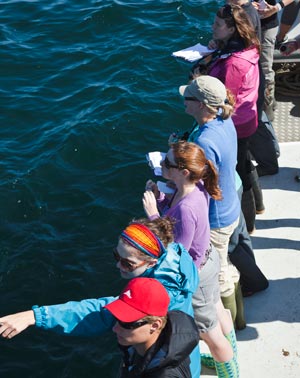 |
| Students line up along the side of the boat and scan the water for marine life. (Damian Lidgard Photo) |
Scientists named the North Atlantic right whale Eubalaena glacialis, which in Latin means "goodвҖқ or "true" whale of the ice. But English-speaking whalers referred to this massive creature as the вҖңrightвҖқ whale, meaning it was the right whale to kill. Relatively easy to hunt and with a thick layer of blubber that kept it afloat as it was brought in, the North Atlantic right whale was heavily hunted for hundreds of years.
Their numbers are still so depleted вҖ“ itвҖҷs estimated there are only 400 animals remaining вҖ“ that scientists worry about their continued survival.
With right whales being so rare, the sight of them in the Bay of Fundy is always exciting, even more so when theyвҖҷre being so frisky. Which is how a group of РВјУЖВБщәПІКҝӘҪұЦұІҘ students chanced upon themвҖ”a female on her back, her big white belly breaking the surface, as several males swam around and beneath her, vying for her attention.
The 23 students in the class Field Studies of Marine Mammals looked on transfixed from a lobster boat. There was even some cheering.
SEE MORE PHOTOS:МэA lobster boat for a classroom (Photos by Damian Lidgard)
вҖңItвҖҷs always rather strange to see because itвҖҷs not the time when theyвҖҷre mating. They do that in the Caribbean in the winter,вҖқ explains Deborah Austin. вҖңWe donвҖҷt see much of the males, just the occasional tail or pectoral flipper.вҖқ
But unusual sightings are par for the course, one of several field-trip intensive classes offered over the summer as part of the Faculty of ScienceвҖҷs Seaside Program. Taught by Dr. Austin, a species-at-risk biologist with Parks Canada, and Damian Lidgard, a post doctoral fellow with the Ocean Tracking Network, the half-credit class takes place over two weeks just before the start of the fall academic term. It entails several days of camping on Digby Neck, a peninsula that stretches southwest from Digby toward Brier Island, and going out to sea for hours at a time to see whatвҖҷs out there. ThereвҖҷs also lectures and lab activities, including necropsies (post-mortem examinations to determine cause of death) of a harbour porpoise and a harbour seal. The students conclude the animals died by drowning, having beenМэsnagged in herring nets.
Spying the high-spirited North Atlantic right whales is a thrill and thereвҖҷs lots more to ooh and aah over. Students, dressed in rain slickers and rubber boots, scan the waters of the Bay of Fundy looking for the slick curve of a harbor porpoise or the plume of water from a humpbackвҖҷs blowhole. Out at sea, they spot fin, minke and pilot whales; white-sided dolphins, harbour porpoises, grey seals and harbour seals; storm petrels, sheerwaters, puffins, phalaropes and gannets. ThereвҖҷs been some unusual sightings this summer too, including a hummingbird far out at sea and a massive ocean sunfish, more commonly found in warmer waters.
The students have lots to do on the boat. Divided into groups, they observe how the marine mammals behave around the boat. They take photos of tailsМэand finsМэand callosities, large patches of raised tissue on the heads of the right whales, to identify individual animals. Other jobs include recording the seabirds that accompany various marine mammals or timing the dives of humpbacks during feeding.
For Dr. Austin, teaching the Seaside class is always enjoyable.
вҖңItвҖҷs pretty incredible to see the students, many of whom have never been on a boat before let alone on a boat on the ocean,вҖқ she says. вҖңFor me, itвҖҷs exhilarating to see students seeing something so amazing, like an endangered whale. TheyвҖҷre so excited and keen, it just gets you excited and keen too.вҖқ
LINK:
